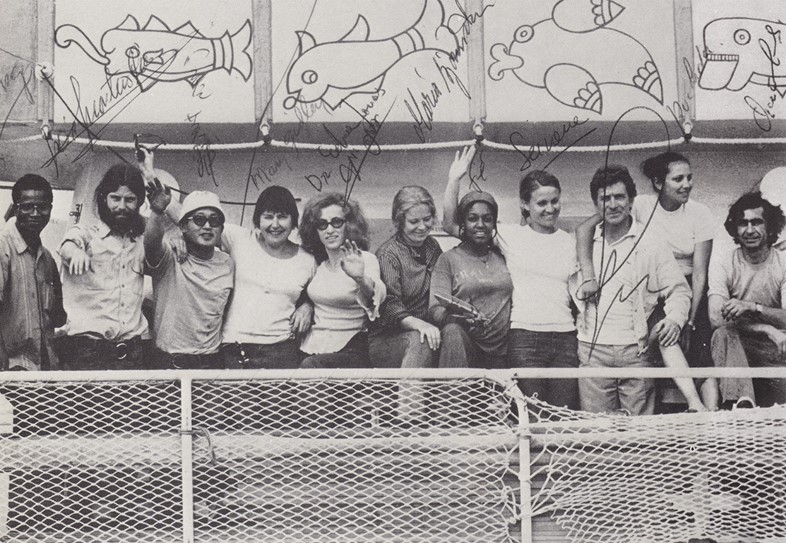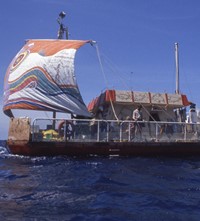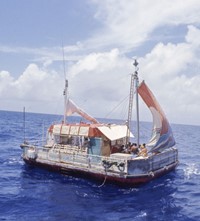In 1973, a Mexican anthropologist and ten people set sail on a quest to find an answer to world peace
- TextDaisy Woodward
In 1973, as the Vietnam war raged, a Mexican anthropologist named Santiago Genovés had a wildly revolutionary idea: to pick ten participants from different cultural demographics around the globe, and sail with them across the Atlantic Ocean aboard a small engineless raft, dubbed the Acali. The purpose of this three-month experiment was, Genovés proposed, to find an answer to world peace. “In a crisis or difficult situations,” he wrote, “humans show their true behaviour”. And by “true behaviour”, the scientist meant violence; Genovés hoped that by creating a microcosm of the real world aboard a seven-by-12-metre steel vessel, where danger was inevitable and escape impossible, he would come to understand the origins of human aggression.
Ensuring a diverse crew – among them Bernardo, an Angolan Catholic priest; Etsuke, a Japanese photographer; and Jose-Maria, a Uruguayan anthropologist – was only one part of Genovés’ master plan. Keen to harness – and put to the test – the force of the burgeoning feminist movement, he opted to place women in the raft’s most important roles. The Swedish captain, Maria Björnstam, was the first woman in the world to secure a maritime command certificate, while Israeli doctor, Edna, and French scuba diver, Servane, occupied the other key positions of life onboard.
The scientist was also intrigued by the purported connection between violence and sexual attraction, and thus deliberately chose “sexually attractive” participants from the thousands who responded to his international newspaper ads. Later the Acali would be dubbed “The Sex Raft” by the media, who followed the raft’s progress with salacious delight. Prior to setting off, all participants were subjected to extensive physical and psychological testing, involving multiple questionnaires. “What would you do if threatened?” Genovés wanted to know. “Would you kill someone? What would make you kill someone?” Crew selected, the scientist and his laboratory mice met in the Canary Islands, and, on May 11, 1973, they set sail for Mexico on a journey more testing than even Genovés could imagine. Fortunately for the curious among us, new documentary, The Raft, by Swedish filmmaker Marcus Lindeen, offers extraordinary insight into the 101-day voyage, revisiting the original footage (captured by Etsuke on 16mm film), and reuniting the seven surviving participants for the first time in over four decades.

“It started as a failed theatre project actually,” Lindeen tells us of the film’s origins. “I was setting out to reunite a group of older Swedish actors in Stockholm who had all been part of a radical theatre production in the 70s. I wanted to bring them together on the same stage they’d performed on and to hear their perspective years on.” This was logistically impossible, as it turned out – but the concept of reuniting a group of 70s radicals had embedded itself in Lindeen’s mind. “By coincidence, not long after, I read this book about the 100 strangest scientific experiments of all time, and the Acali was one of them. It was headlined ‘The Sex Raft’, and of course I was curious to know more. When I started to read about it, I was amazed by how truly experimental and adventurous the story was, but rather than being ideological or political like so many other 70s concepts, it was more about science and human behaviour; wanting to know the truth about how we function as people.”
Pulling off the documentary, however, was no mean feat. “It was really complicated because in his book about the experiment, Santiago had given the participants pseudonyms,” Lindeen explains. “So tracking them down from around the world, 43 years later, without their real names, was like detective work. It took me and a team of researchers almost two years.” One of the biggest early breakthroughs, the filmmaker recalls, was discovering captain Maria Björnstam. “Maria was one of the first people I spoke to, but she was very hesitant to be a part of the film. She felt ashamed about how the journey was portrayed in the press – as ‘The Sex Raft’. Also, as a woman in the captain profession, she felt humiliated by the way she had been treated by Santiago [a major element of the story’s plot].” After numerous discussions, and showing Björnstam his first documentary, The Regretters – “a conversation between two older men who both regretted going through sexual reassignment surgery to become women” – however, he finally managed to convince the female pioneer of his integrity as a storyteller.
“I’ll never forget the day she agreed to be a part of the project,” says Lindeen. “We were in her apartment in Gothenburg and she brought down a suitcase from the attic and said, ‘In here I have everything from the trip, but I haven’t opened it for 43 years.’ For a documentary filmmaker it was like gold! We opened it together and in there was everything that began the journey for me – her old address book, which helped to find the other participants, the original blueprints, photos and much more.” The filmmaker experienced a similar twist of fate unearthing the film footage: after months of searching they discovered them in a university archive in Mexico City, having been incorrectly labelled in a lab report. “I’ve been very lucky,” he chuckles.
The final impetus for going ahead with the film came when Lindeen finally tracked down all seven of the surviving members of the Acali crew: not only were they enthusiastic to be a part of his grand reunion, but they also proved exceptionally giving and open in their recollections of the journey – involving tales of mutiny and murder plots. “I was surprised that the participants’ version of what happened was very different to the one that Santiago had told in his book, and that was really what gave me confidence in how interesting our film could be.”
And there’s no doubt that his hunch was correct: the resulting film – which sees the experiment’s protagonists meet once again aboard a wooden, true-to-size reconstruction of the raft, built by production designer and regular Lars Von Trier collaborator, Simone Grau Roney – is entirely gripping. Standing on the vessel, lit like a stage in a blackened studio, the seven survivors share memories and insightful, often haunting backstories that they had hitherto withheld from one another. “If I were isolated for three months with a group of strangers, I’d presume I wouldn’t have any secrets from them, but it was quite the opposite,” Lindeen notes. “I think Santiago made them feel like anything personal would be used against them.” And indeed, it is the character of Genovés who turns out to be the most intriguing of all. As the director reflects, “Santiago is such a complex character and at first I kind of dismissed him as being this crazy scientist seeking fame and glory but now I think he was almost like a poet of some kind – taking this raft out into the ocean to discover the truth of our inner-lives. It’s like a Greek myth.”
Without wanting to give any spoilers away, The Raft is the twist and turn-filled tale of an experiment deemed by its creator a gigantic failure, but which in fact reveals many deeply moving and reassuring truths about mankind, and our ability to overcome our differences. “I know people will want to watch it to discover more about ‘The Sex Raft’, and the dangerous events onboard,” laughs Lindeen, “and they will. But the film’s message is ultimately a very hopeful one, especially in these times that we’re living in where there’s so much confliction, racism and polarisation, and I hope that’s something positive that viewers can take away from it.”
The Raft is in cinemas nationwide.















